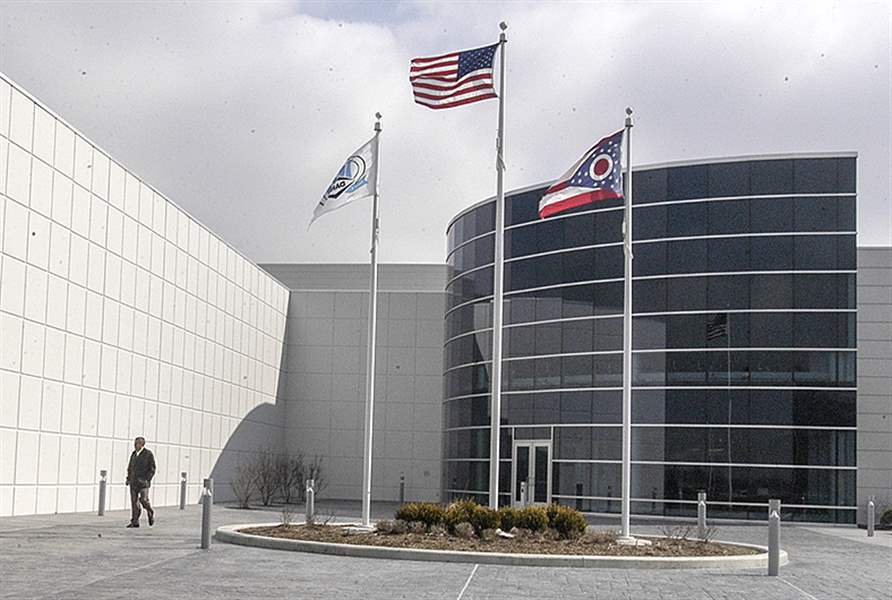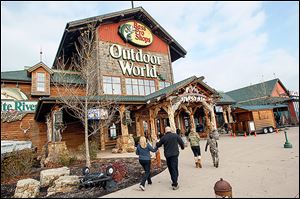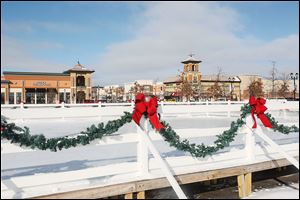
Development areas fostering growth
Concept keeps communities from squabbling, experts say
1/26/2014
Flags fly at the Dana ASG Technology Center. The site is in Monclova Township, formerly Toledo-owned land, and adjacent to Maumee. A JEDZ kept the peace among the communities.
THE BLADE
Buy This Image

The zone set up in 1992 between Toledo and Rossford contains successful retail sites such as Bass Pro Shops. The 600 acres covers the so-called ‘Crossroads of America’ development location.
The year was 2002.
In April, Dana Corp. announced plans to build a 170,000-square-foot technical center that would house 500 employees and possibly generate additional jobs on a site just west of U.S. 23 between Maumee-Western and Monclova roads.
The site was in Monclova Township. On land owned by the city of Toledo. And located directly adjacent to Maumee.
All Dana wanted was a new tech center and a way to keep its engineers in the Toledo area. But the site it chose had the potential to pit Toledo, Maumee, and Monclova Township against each other in a fractious governmental squabble.
Fortunately, the Ohio General Assembly had foreseen such dilemmas and come up with the perfect solution in 1985 — Joint Economic Development Zones, or JEDZ.
With all three parties involved, a 550-acre zone was formed in 2003, and everyone got something.
Toledo sold the land to Dana, Maumee annexed the land, and Monclova Township got to levy property taxes on the site like it always had, plus it got a third of the income tax levied on Dana. Toledo and Maumee got to split two-thirds of the tax revenues.
Eventually, Dana moved its headquarters to the site. With the nearby acreage now part of the economic development zone and containing developed infrastructure, officials from Rudolph/Libbe Inc. told Toledo City Council last month that a mystery company purchased 37 acres of land, known as the Triad business park and in the development zone. This company plans to invest $10 million in a new headquarters and factory in the zone, the officials said.
“I would say the agreement worked out fantastic for all the parties,” said Maumee administrator John Jezak. “It opened up the door and paved the way to solve the bloody fistfight between Toledo, Maumee, and Monclova,” he added.
“I’m convinced that had we not done that deal with the authorizing legislation in it, it’s possible we could not have had the tech center here, and we could have lost Dana altogether from the area,” Mr. Jezak said.
When they were first authorized, Joint Economic Development Zones — and Joint Economic Development Districts starting in 1993 — were mostly used for two purposes: to keep cities from voraciously annexing village or township lands and as a way to provide water services to rural townships or villages.
In fact, Toledo still has a JEDZ with the village of Berkey to provide it with water services even though no development has occurred in the economic development zone there. Toledo also has water-sewer JEDZs with Rossford, Perrysburg, and Northwood.
But as they have evolved, the zones have become strong sources of revenue while also becoming a key driver of economic development in northwest Ohio.
“They are an effective tool, they really are,” said Matt Sapara, Toledo department of development director. “In an age when different agencies are finally starting to work together, these are a great tool for bringing people together.”

Mr. Sapara points to the key JEDZ between Toledo, Maumee, and Monclova Township that is bringing in the mystery company. “Ten years ago, it wouldn’t have been possible,” he said.
But creation of the zone fostered cooperation between all the parties. “If you take that example of Triad business park at Monclova and Jerome Roads, we acquired that property long ago, but with the zone we created the infrastructure. And now you are seeing these new jobs being created as a result,” Mr. Sapara said.
In addition to the Triad business park land, Toledo has another 700-acre zone with Maumee, established in 1991, that includes part of Arrowhead Industrial Park, the operations of Spartan Chemical Co., part of the Fallen Timbers battleground, and the Shops at Fallen Timbers shopping center.
Toledo also has a 2005 zone agreement with Oregon over the 51-acre site of a planned $350 million coke plant. However, the plant was never built.
It also has a 127-acre joint economic development district agreement with Perrysburg Township covering the $87 million FedEx Ground facility in the Ampoint Industrial Park off of Buck Road in the township.
Under the district rules, Toledo and Perrysburg Township split the tax revenues evenly.
Toledo has two Joint Economic Development District agreements, a 2005 deal with Lake Township to cover land surrounding Toledo-owned Metcalf Field, and a 2010 agreement with Troy Township covering 460 acres south of the Ohio Turnpike at Stony Ridge. Home Depot is building a distribution warehouse in the Troy Township zone.
The main difference between an economic development zone and an economic development district is that a business petition and a government board or council can create a district on their own. A zone requires a vote of residents in the zone.
Perhaps the most well-known and most successful zone is the one between Toledo and Rossford that covers the so-called Crossroads of America development site.
Set up in 1992, the zone has helped foster successful retail and other development on the 600-acre site north of U.S. 20 and east of I-75, including a Bass Pro Shops store and a Camping World store that is being built.
More corridors
Brian McMahon, president of Danberry National Ltd., which has helped market properties in the area, which is bisected by the Ohio Turnpike, said he believes that the area’s future economic sources of revenues exist in the various economic development zones and that local governments should work to establish more, especially along the turnpike, which provides great transportation logistics for businesses.
“In Indiana, they took revenues and created incentives for people who promoted development at the interchanges on the turnpike. It meant more revenues for the entire turnpike corridor,” Mr. McMahon said.
“I think the idea of these [local] combined corridors being developed is a good one. I think people will be surprised at how much economic development land that’s available is already zoned for business,” he said.
“When these companies come to town, they want to see where the sites exist with the utilities and zoning, that have the so-called ‘entitlements.’ If you don’t have the entitlements in place, you don’t make the list, and they go elsewhere,” Mr. McMahon said.
“FedEx had the utilities and the zoning. That’s why they went to Perrysburg Township and you got the zone there between Rossford and Northwood,” he said.
“I’ve come to the conclusion that we’re all in it together. When you look at the areas in this country that are accessible, you’ll find there’s regional cooperation, and that’s what we need,” Mr. McMahon added.

The Shops at Fallen Timbers mall is in a zone set up between Toledo and Maumee in 1991. Besides the shopping center, the 700-acre site includes Arrowhead Industrial Park, Spartan Chemical Co., and part of the Fallen Timbers battleground.
Mr. Sapara said he agrees that the more economic development zones the better — Toledo, Swanton, and Monclova Township have a JEDD pending that would cover Toledo Express Airport and the nearby turnpike interchange — as a way to unite the area in a single economic development goal.
“People always ask me what we would consider a success for Lucas County. I would say it is if the entire county became a JEDZ, and we all shared those resources,” Mr. Sapara said.
The Toledo economic development director said if more zones and districts are established it should be made clear that the revenues from them will go back to those zones and districts for infrastructure improvements and economic development. Otherwise, there’s a risk that businesses in those zones would just see the move as a “money grab,” he added.
‘Mischievous activity’
That “money-grab” scenario greatly bothers State Rep. Kirk Schuring (R., Canton), the author of the 1993 law that created joint economic development districts.
Lately in central Ohio, Mr. Schuring said, many townships and cities have been creating economic development districts in a willy-nilly fashion with no other purpose than to tax an existing business in a township. A township cannot levy income taxes on its own, but it can collect them under a JEDZ or JEDD.
“The [joint economic development] districts have been used far and wide for good economic development purposes. And I am heartened by what I’ve seen in northwest Ohio and northeast Ohio. They’re using them effectively for economic development,” Mr. Schuring said.
“However, in central Ohio there has been some mischievous activity that has not hit the rest of the state yet. In central Ohio they are using zones and districts to cherry-pick large employers in a township and use the zones to take the income tax from those folks with no economic development involved in it whatsoever,” Mr. Schuring said.
Last year, Mr. Schuring introduced House Bill 289, which was recently revised in committee to try to end abuse of JEDDs and JEDZs.
If passed, the legislation would require a tax incentive review council be set up to evaluate the agreements when formed or renewed. “It will allow for the economic development in the zone to be monitored and to be sure that it is being followed. If it’s not being followed, it can recommend that it be adjusted, and if not, then the agreement can be dissolved,” Mr. Schuring said.
“To perpetuate a tax grab on taxpayers is not fair, and doing it under the guise of economic development with no economic development involved is just unconscionable from my viewpoint,” Mr. Schuring said.
“I’m glad to say that none of this is going on in northwest Ohio,” he added. “But what we’re afraid of is if we allow this to continue it will hit other parts of the state.”
Contact Jon Chavez at: jchavez@theblade.com or 419-724-6128.